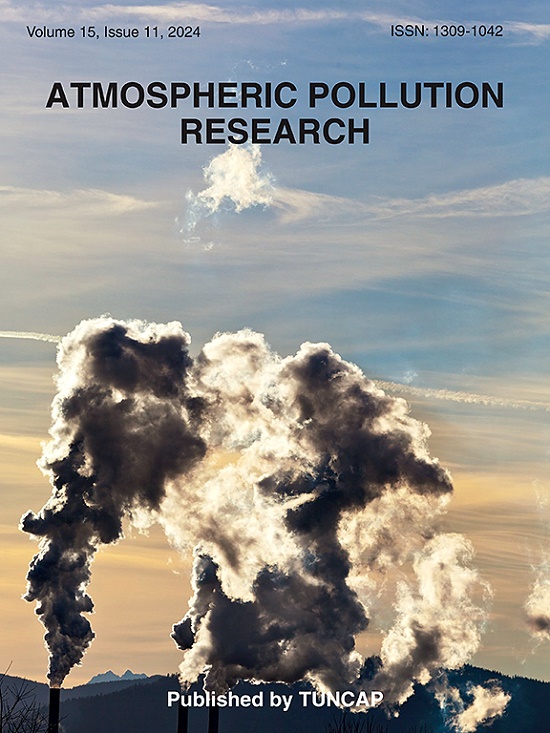Estimation and analysis of CO2 column concentrations (XCO2) in the Yangtze River Delta of China based on multi-source data and machine learning
IF 3.9
3区 环境科学与生态学
Q2 ENVIRONMENTAL SCIENCES
引用次数: 0
Abstract
Carbon dioxide (CO2) is one of the most significant greenhouse gases in the atmosphere and plays a crucial role in global warming. Currently, the temporal resolution for XCO2 from the satellite is low, and the ground-based XCO2 observation station is limited. There is an urgent need for a XCO2 dataset with high temporal and spatial resolution. Consequently, based on the random forest algorithm, we have developed an optimized model for predicting XCO2 with a spatial resolution of 0.25° × 0.25° and a temporal resolution of 1 h for the Yangtze River Delta in 2020. The multi-source data, such as the ground-observation XCO2 from the TCCON, as well as meteorological parameters, aerosols, surface vegetation index, and emission source factors from the ERA5, MERRA-2, MODIS, and MEIC datasets, were used in this study. The results indicate that the random forest model is well-suited for predicting XCO2. Specifically, the model performs more optimally when utilizing 20 variables, including solar zenith angle, normalized vegetation index, and carbon emission data as input parameters with the prediction RMSE and R2 of 1.031 × 10−6 and 0.940. The MAE for predicted XCO2 at Xianghe and Hefei stations are 0.628 × 10−6 and 0.550 × 10−6, respectively, marking a substantial increase in accuracy compared to GOSAT data. In 2020, daily variations of XCO2 follow a pattern of higher concentrations at night and lower concentrations during the day, negatively correlating with changes in the atmospheric boundary layer height. The inter-monthly and seasonal variations reveal smaller concentrations in summer and higher concentrations in winter. The minimum concentration occurs in July at 409.64 × 10−6, while the maximum concentration occurs in November at 413.11 × 10−6. Spatially, XCO2 is higher in the northern areas and lower in the southern regions, showing a negative correlation with the NDVI and a positive correlation with anthropogenic carbon emissions. The XCO2 dataset calculated in this study with continuous spatial and temporal resolutions could address the limitations of satellite products with low temporal resolution and a limited number of ground observation stations.
基于多源数据和机器学习的长江三角洲CO2柱浓度估算与分析
二氧化碳(CO2)是大气中最重要的温室气体之一,对全球变暖起着至关重要的作用。目前,卫星对XCO2的时间分辨率较低,地面XCO2观测站有限。目前迫切需要一个具有高时空分辨率的XCO2数据集。基于随机森林算法,建立了2020年长江三角洲XCO2预测模型,模型空间分辨率为0.25°× 0.25°,时间分辨率为1 h。本研究利用TCCON地面观测XCO2等多源数据,以及ERA5、MERRA-2、MODIS和MEIC等气象参数、气溶胶、地表植被指数和排放源因子。结果表明,随机森林模型能较好地预测XCO2。其中,利用太阳天顶角、归一化植被指数和碳排放数据等20个变量作为输入参数,预测RMSE和R2分别为1.031 × 10−6和0.940,模型表现更为理想。香河站和合肥站预测XCO2的MAE分别为0.628 × 10−6和0.550 × 10−6,精度较GOSAT数据有较大提高。在2020年,XCO2的日变化遵循夜间浓度较高、白天浓度较低的模式,与大气边界层高度的变化呈负相关。月间和季节变化表现为夏季浓度较低,冬季浓度较高。最小浓度出现在7月,为409.64 × 10−6;最大浓度出现在11月,为413.11 × 10−6。从空间上看,XCO2北部较高,南部较低,与NDVI呈负相关,与人为碳排放呈正相关。本研究计算的XCO2数据集具有连续的时空分辨率,可以解决卫星产品时间分辨率低和地面观测站数量有限的局限性。
本文章由计算机程序翻译,如有差异,请以英文原文为准。
求助全文
约1分钟内获得全文
求助全文
来源期刊

Atmospheric Pollution Research
ENVIRONMENTAL SCIENCES-
CiteScore
8.30
自引率
6.70%
发文量
256
审稿时长
36 days
期刊介绍:
Atmospheric Pollution Research (APR) is an international journal designed for the publication of articles on air pollution. Papers should present novel experimental results, theory and modeling of air pollution on local, regional, or global scales. Areas covered are research on inorganic, organic, and persistent organic air pollutants, air quality monitoring, air quality management, atmospheric dispersion and transport, air-surface (soil, water, and vegetation) exchange of pollutants, dry and wet deposition, indoor air quality, exposure assessment, health effects, satellite measurements, natural emissions, atmospheric chemistry, greenhouse gases, and effects on climate change.
 求助内容:
求助内容: 应助结果提醒方式:
应助结果提醒方式:


